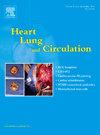Incidence, Predictors, and Outcomes of Venous and Arterial Thrombosis in COVID-19: A Nationwide Inpatient Analysis
IF 2.2
4区 医学
Q2 CARDIAC & CARDIOVASCULAR SYSTEMS
引用次数: 0
Abstract
Background
Coronavirus disease 2019 (COVID-19) is known to increase the risk of venous thromboembolism (VTE) and arterial thromboembolism (ATE). However, the incidence, predictors, and outcomes of clinical thrombosis for inpatients with COVID-19 are not well known. This study aimed to enhance our understanding of clinical thrombosis in COVID-19, its associated factors, and mortality outcomes.
Method
Hospitalised adult (≥18 years of age) patients with COVID-19 in 2020 were retrospectively identified from the US National Inpatient Sample database. Clinical characteristics, incident VTE, ATE, and in-hospital mortality outcomes were recorded. Multivariable logistic regression was performed to identify clinical factors associated with thrombosis and in-hospital mortality in COVID-19 inpatients.
Results
A total of 1,583,135 adult patients with COVID-19 in the year 2020 were identified from the National Inpatient Sample database; patients with thrombosis were 41% females with a mean age of 65.4 (65.1–65.6) years. The incidence of thrombosis was 6.1% (97,185), including VTE at 4.8% (76,125), ATE at 3.0% (47,790), and the in-hospital mortality rate was 13.4% (212,785). Patients with thrombosis were more likely to have respiratory symptoms of COVID-19 (76.7% vs 75%, p<0.001) compared with patients without thrombosis. The main factors associated with overall thrombosis, VTE, and ATE were paralysis, ventilation, solid tumours without metastasis, metastatic cancer, and acute liver failure. Although all thrombosis categories were associated with higher in-hospital mortality for COVID-19 inpatients in univariable analyses (p<0.001), they were not in multivariable analyses—thrombosis (odds ratio [OR] 1.24; 95% confidence interval [CI] 0.90–1.70; p=0.19), VTE (OR 0.70; 95% CI 0.52–1.00; p=0.05), and ATE (OR 1.07; 95% CI 0.92–1.25; p=0.36).
Conclusions
The association of COVID-19 with thrombosis and VTE increases with increasing severity of the COVID-19 disease. Risk stratification of thrombosis is crucial in COVID-19 patients to determine the necessity of thromboprophylaxis.
COVID-19 中静脉和动脉血栓的发生率、预测因素和结果:全国住院病人分析
背景:已知冠状病毒病 2019(COVID-19)会增加静脉血栓栓塞(VTE)和动脉血栓栓塞(ATE)的风险。然而,COVID-19住院患者临床血栓形成的发生率、预测因素和结果尚不十分清楚。本研究旨在加深我们对 COVID-19 临床血栓形成、其相关因素和死亡率结果的了解:方法:从美国全国住院病人抽样数据库中回顾性地识别了 2020 年 COVID-19 的住院成人(≥18 岁)患者。记录临床特征、VTE事件、ATE和院内死亡结果。通过多变量逻辑回归确定了与 COVID-19 住院患者血栓形成和院内死亡率相关的临床因素:从全国住院患者抽样数据库中确定了2020年的1,583,135名COVID-19成年患者;血栓形成患者中41%为女性,平均年龄为65.4(65.1-65.6)岁。血栓形成的发病率为 6.1%(97,185 例),其中 VTE 为 4.8%(76,125 例),ATE 为 3.0%(47,790 例),院内死亡率为 13.4%(212,785 例)。血栓形成患者更有可能出现COVID-19的呼吸道症状(76.7% vs 75%,P结论:COVID-19与血栓形成和VTE的相关性随着COVID-19疾病严重程度的增加而增加。对 COVID-19 患者进行血栓形成风险分层对于确定是否需要采取血栓预防措施至关重要。
本文章由计算机程序翻译,如有差异,请以英文原文为准。
求助全文
约1分钟内获得全文
求助全文
来源期刊

Heart, Lung and Circulation
CARDIAC & CARDIOVASCULAR SYSTEMS-
CiteScore
4.50
自引率
3.80%
发文量
912
审稿时长
11.9 weeks
期刊介绍:
Heart, Lung and Circulation publishes articles integrating clinical and research activities in the fields of basic cardiovascular science, clinical cardiology and cardiac surgery, with a focus on emerging issues in cardiovascular disease. The journal promotes multidisciplinary dialogue between cardiologists, cardiothoracic surgeons, cardio-pulmonary physicians and cardiovascular scientists.
 求助内容:
求助内容: 应助结果提醒方式:
应助结果提醒方式:


